CHEVROLET TAHOE 1996 1.G Service Manual
Manufacturer: CHEVROLET, Model Year: 1996, Model line: TAHOE, Model: CHEVROLET TAHOE 1996 1.GPages: 403, PDF Size: 20.63 MB
Page 41 of 403
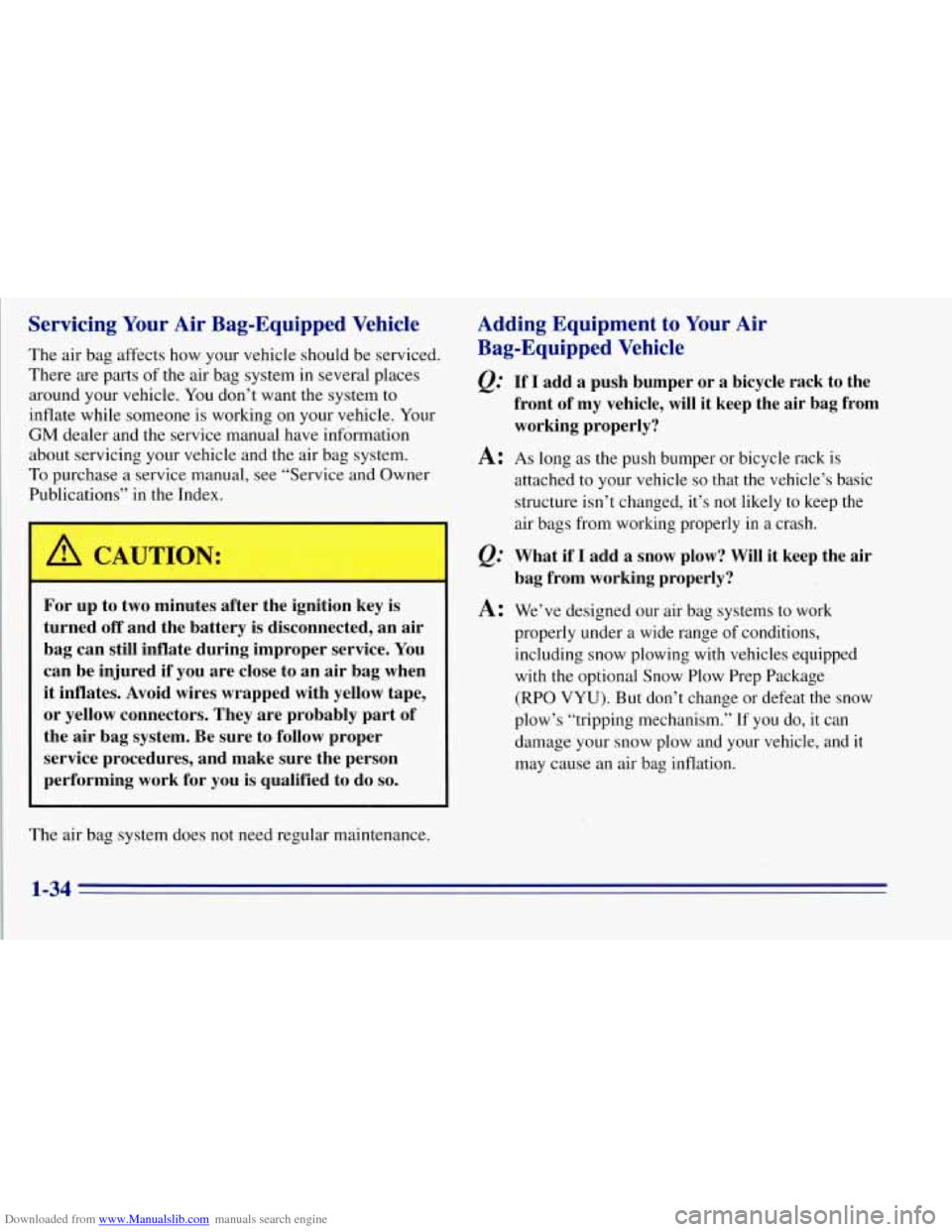
Downloaded from www.Manualslib.com manuals search engine Servicing Your Air Bag-Equipped Vehicle
The air bag affects how your vehicle should be serviced.
There are parts
of the air bag system in several places
around your vehicle. You don’t want the system to
inflate while someone is working on your vehicle. Your
GM dealer and the service manual have information
about servicing your vehicle and the air bag system.
To purchase a service, manual, see “Service and Owner
Publications” in the Index.
For up to two minutes after the ignition key is
turned
off and the battery is disconnected, an air
bag can still inflate during improper service. You
can be injured if you are close to an air bag when
it inflates. Avoid wires wrapped with yellow tape,
or yellow connectors. They are probably part of
the air bag system. Be sure to follow proper
service procedures, and make sure the person
performing work for you is qualified to do
so.
The air bag system does not need regular maintenance.
Adding Equipment to Your Air
Bag-Equipped Vehicle
Q.’ If I add a push bumper or a bicycle rack to the
front of my vehicle, will it keep the air bag from
working properly?
A: As long as the push bumper or bicycle rack is
attached
to your vehicle so that the vehicle’s basic
structure isn’t changed, it’s not likely to keep the
air bags from working properly in a crash.
What if I add a snow plow? Will it keep the air
bag from working properly?
A: We’ve designed our air bag systems to work
properly under a wide range
of conditions,
including snow plowing with vehicles equipped
with the optional Snow Plow Prep Package
(RPO VYU). But don’t change or defeat the snow
plow’s “tripping mechanism.” If you do, it can
damage your snow plow and your vehicle, and it
may cause an air bag inflation.
1-34
Page 42 of 403
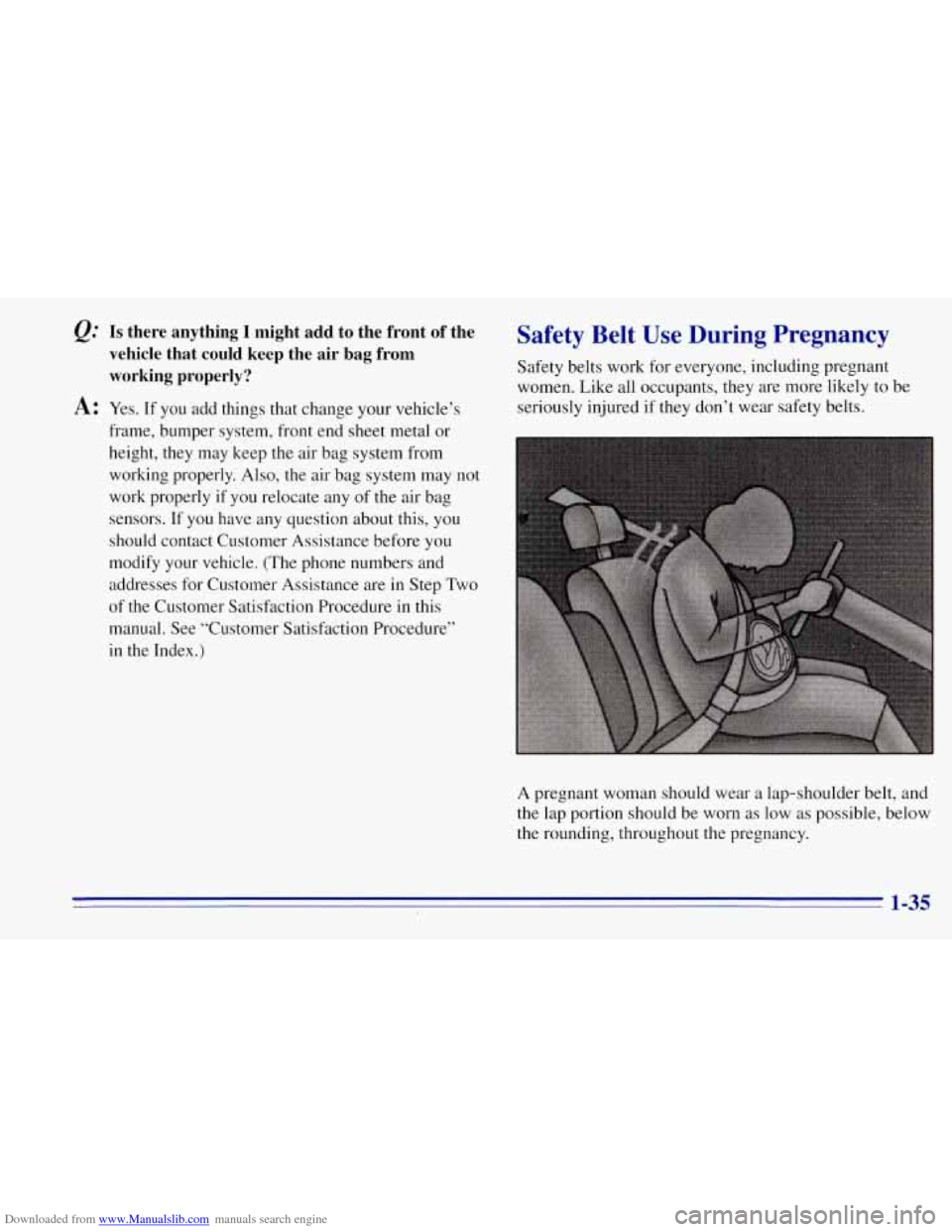
Downloaded from www.Manualslib.com manuals search engine Q:
A:
Is there anything I might add to the front of the
vehicle that could keep the air bag from
working properly?
Yes. If you add things that change your vehicle's
frame, bumper system, front end sheet metal or
height, they may keep the air bag system from
working properly. Also, the air bag system may not
work properly if you relocate any of the air bag
sensors. If you have-any question about this, you
should contact Customer Assistance before you
modify your vehicle. (The phone numbers and
addresses for Customer Assistance are in Step Two
of the Customer Satisfaction Procedure in this
manual. See "Customer Satisfaction Procedure"
in the Index.)
Safety Belt Use During Pregnancy
Safety belts work for everyone, including pregnant
women. Like all occupants, they are more likely to be
seriously injured if they don't wear safety belts.
A pregnant woman should wear a lap-shoulder belt, and
the lap portion should be worn as low
as possible, below
the rounding, throughout the pregnancy.
1-35
Page 43 of 403

Downloaded from www.Manualslib.com manuals search engine The best way to protect the fetus is to protect the
mother. When a safety belt is
worn properly, it’s more
likely that the fetus won’t be hurt in a crash. For
pregnant women, as for anyone, the key to making
safety belts effective is .wearing them properly.
Right Front Passenger Position
The right front passenger’s s,afety belt works the same
way as the driver’s safety belt. See “Driver Position’’
earlier in this section.
#
When the lap belt is pulled out all the way, it will lock.
If it does,, let it go back all the way and start again.
Center. Passenger Position
Lap Belt
If your vehicle has front and rear bench seats, someone
can sit in the center positions.
1-36
Page 44 of 403
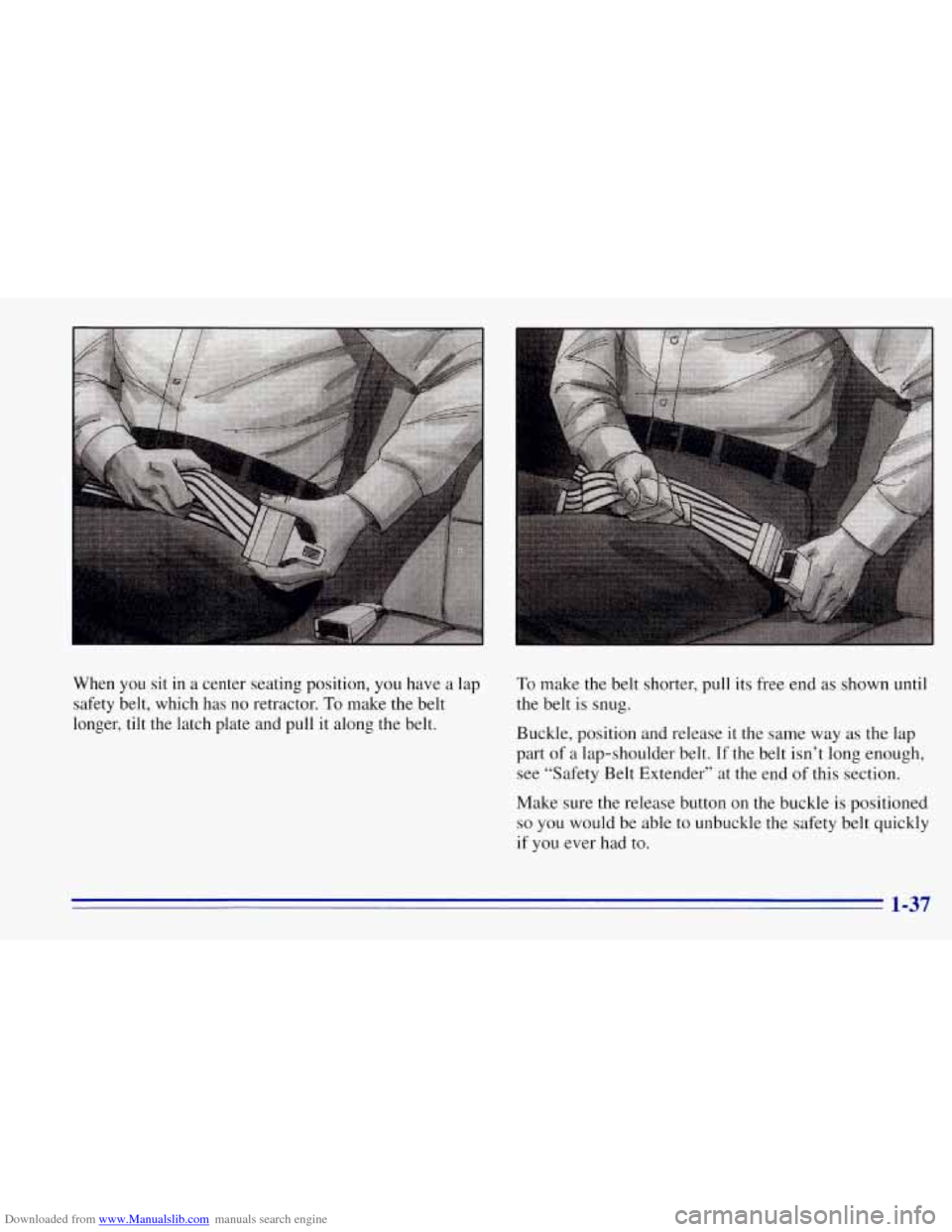
Downloaded from www.Manualslib.com manuals search engine When you sit in a center seating position, you have a lap
safety belt, which has no retractor.
To make the belt
longer, tilt the latch plate and pull it along the belt.
To make the belt shorter, pull its free end as shown until
the belt is snug.
Buckle, position and release
it the same way as the lap
part of
a lap-shoulder belt. If the belt isn’t long enough,
see “Safety Belt Extender’’ at the end
of this section.
Make sure the release button on the buckle is positioned
so you would be able to unbuckle the safety belt quickly
if you ever had to.
1-37
Page 45 of 403
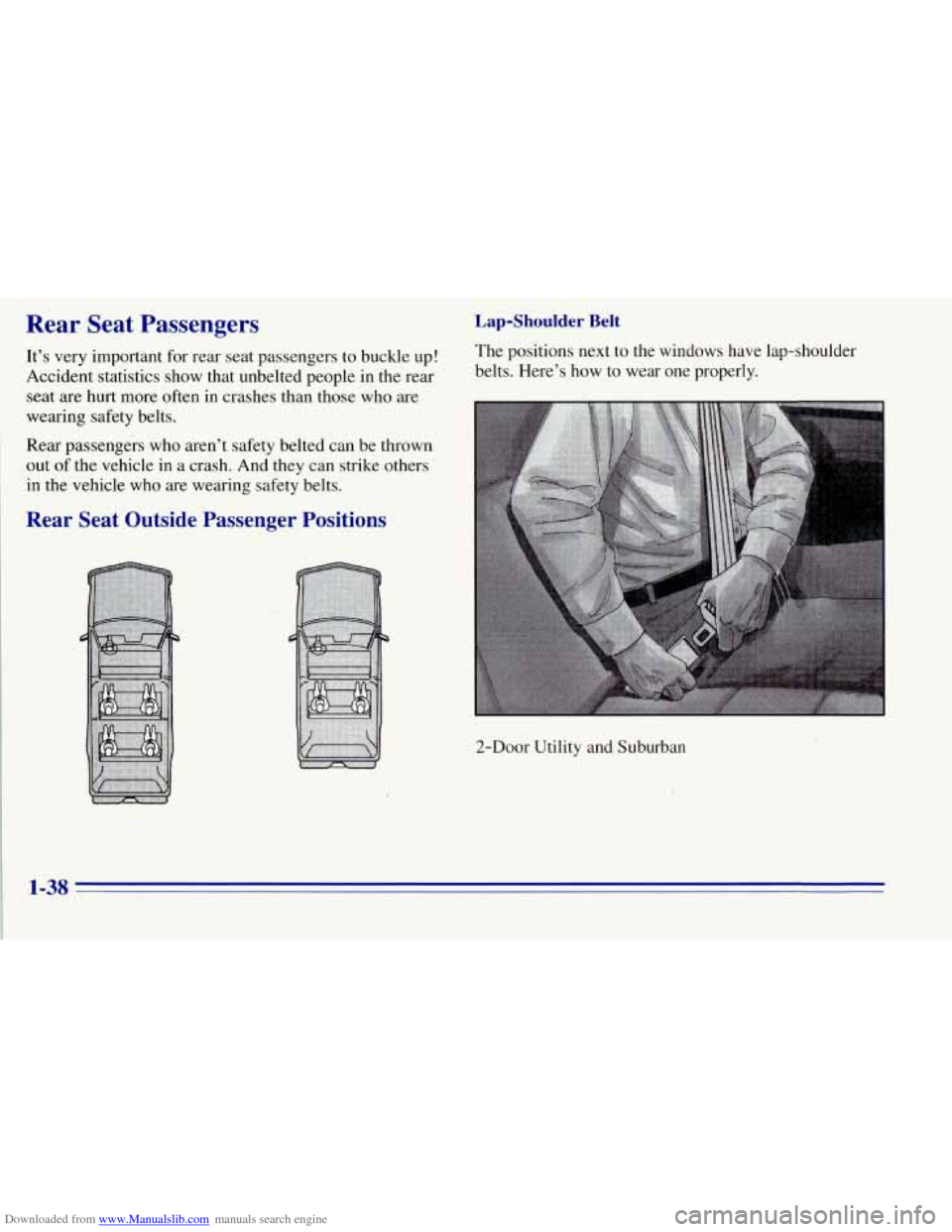
Downloaded from www.Manualslib.com manuals search engine Rear Seat Passengers
It’s very important for rear seat passengers to buckle up!
Accident statistics show that unbelted people in the rear
seat are hurt more often in crashes than those who are
wearing safety belts.
Rear passengers who aren’t safety belted can be thrown
out
of the vehicle in a crash. And they can strike others
in the vehicle who are wearing safety belts.
Rear Seat Outside Passenger Positions
Lap-Shoulder Belt
The positions next to the windows have lap-shoulder
belts. Here’s how to wear one properly.
2-Door Utility and Suburban
1-38
Page 46 of 403
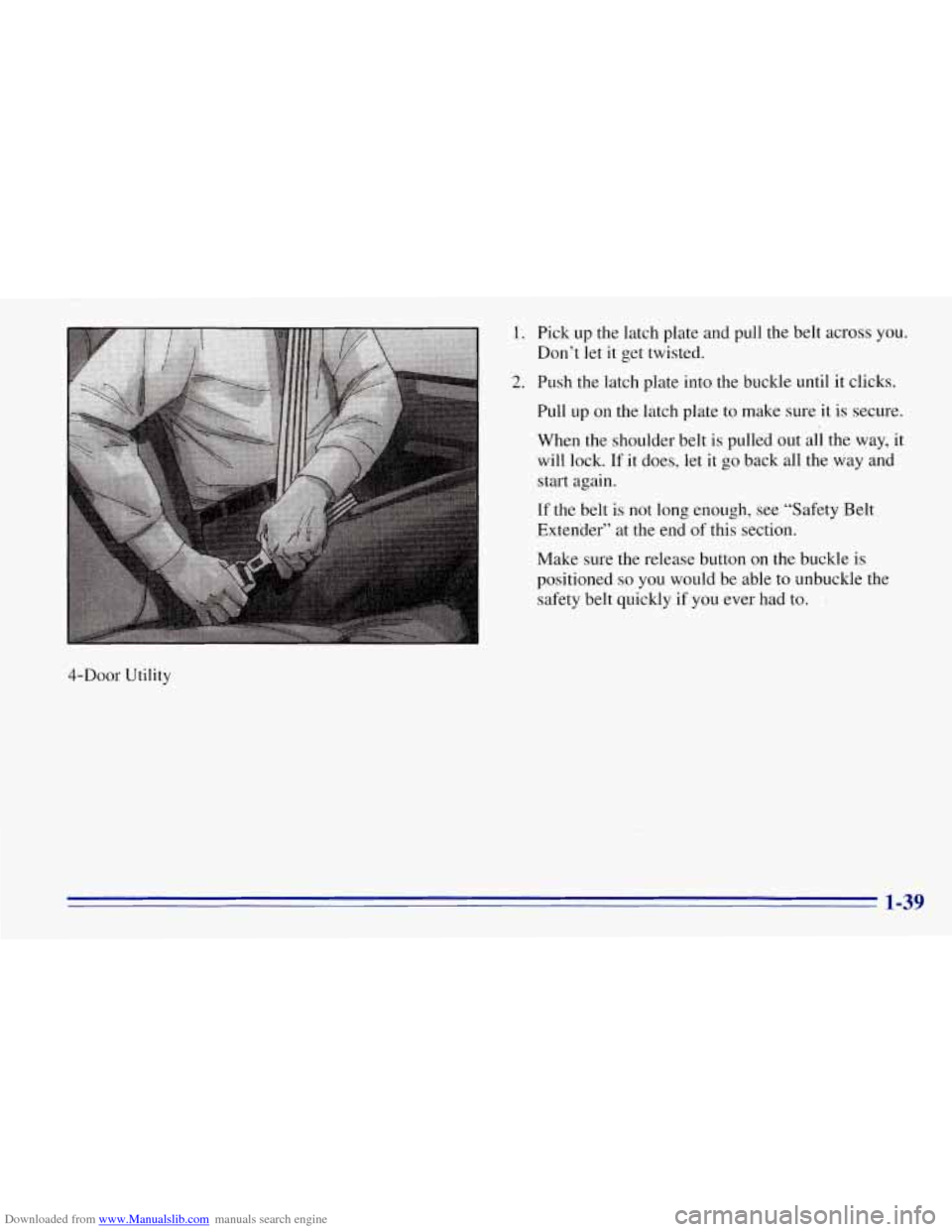
Downloaded from www.Manualslib.com manuals search engine 4-Door Utility
1. Pick up the latch plate and pull the belt across you.
2. Push the latch plate into the buckle until it clicks.
Don’t let it get twisted.
Pull up
on the latch plate to
make sure it is secure.
When the shoulder belt is pulled out all the way, it
will lock. If it does,
let it go back all the way and
start again.
If the belt is not long enough, see “Safety Belt
Extender” at the end
of this section.
Make sure the release button on the buckle is
positioned
so you would be able to unbuckle the
safety belt quickly if you ever had
to.
1-39
Page 47 of 403
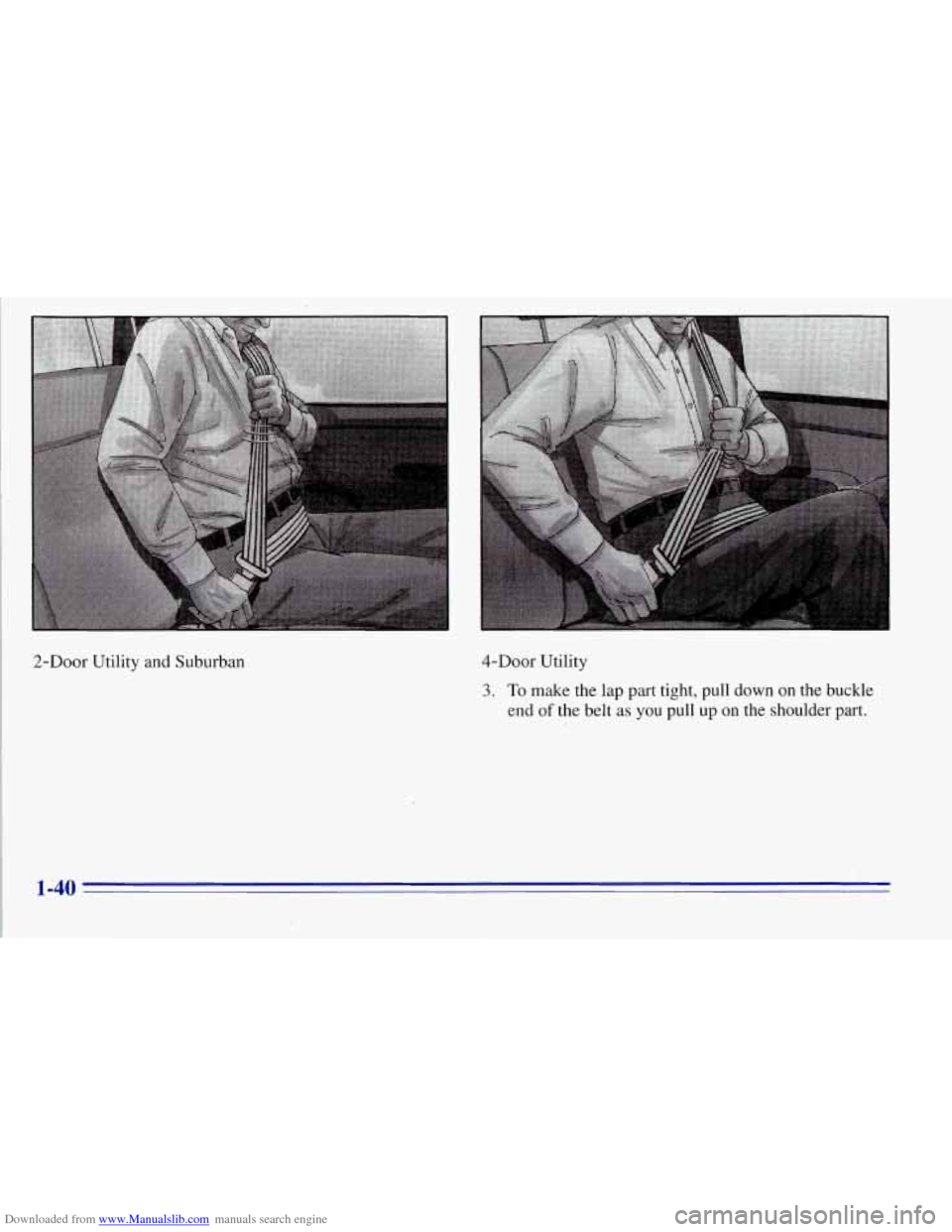
Downloaded from www.Manualslib.com manuals search engine 2-Door Utility and Suburban 4-DOOr
Utility
3. To make the lap part tight, pull down on the buckle
end
of the belt as you pull up on the shoulder part.
1-40
Page 48 of 403
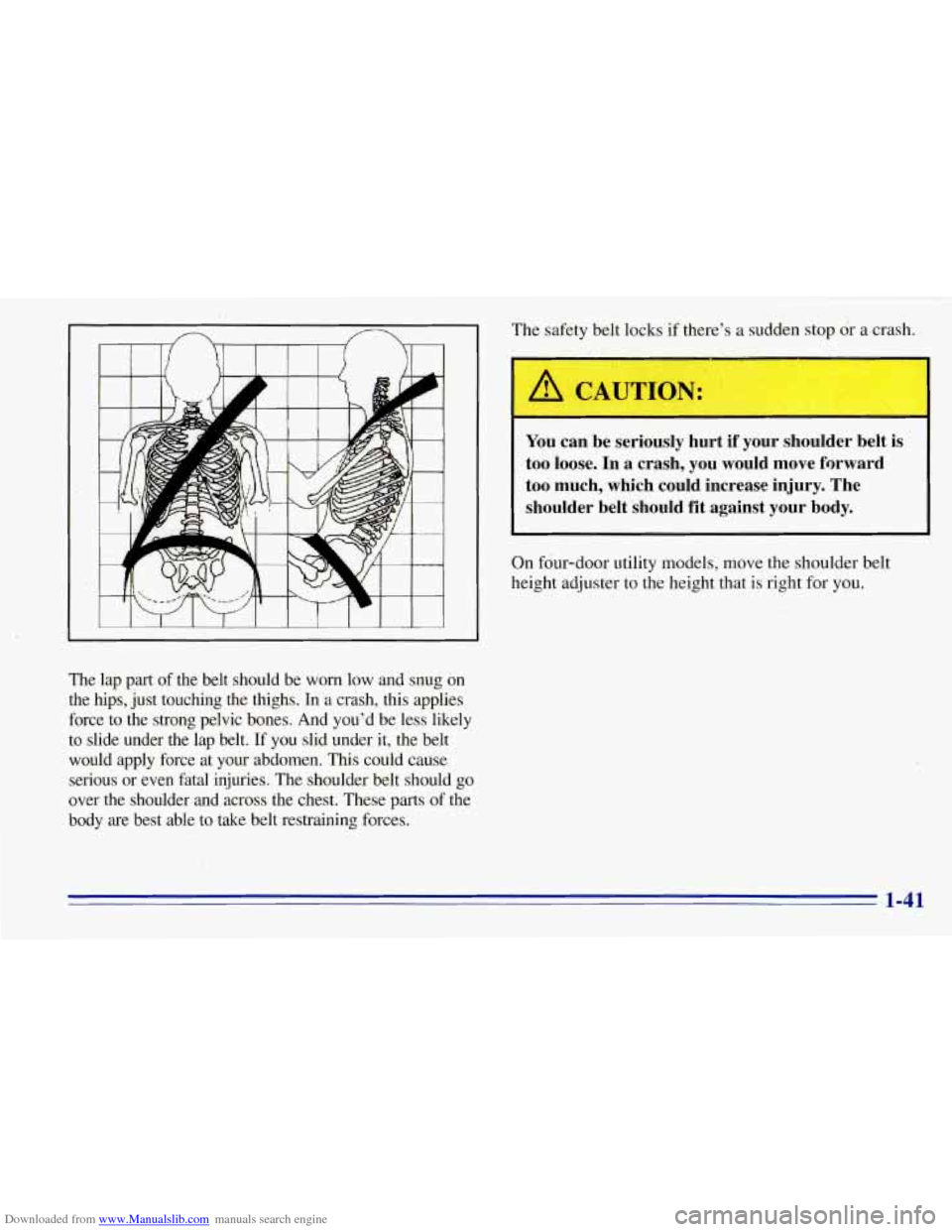
Downloaded from www.Manualslib.com manuals search engine f
The lap part of the belt should be worn low and snug on
the hips, just touching the thighs. In a crash, this applies
force to the strong pelvic bones. And you’d be less likely
to slide under the lap belt.
If you slid under it, the belt
would apply force at your abdomen. This could cause
serious or even fatal injuries. The shoulder belt should
go
over the shoulder and across the chest. These parts of the
body are best able to take belt restraining forces. The
safety belt locks if there’s a sudden stop or a crash.
A
You can be seriously hurt if your shoulder belt is
too loose. In a crash, you would move forward
too much, which could increase injury. The
shoulder belt should fit against your body.
~~~~~
On four-door utility models, move the shoulder belt
height adjuster to the height that is right for
you.
1-41
Page 49 of 403
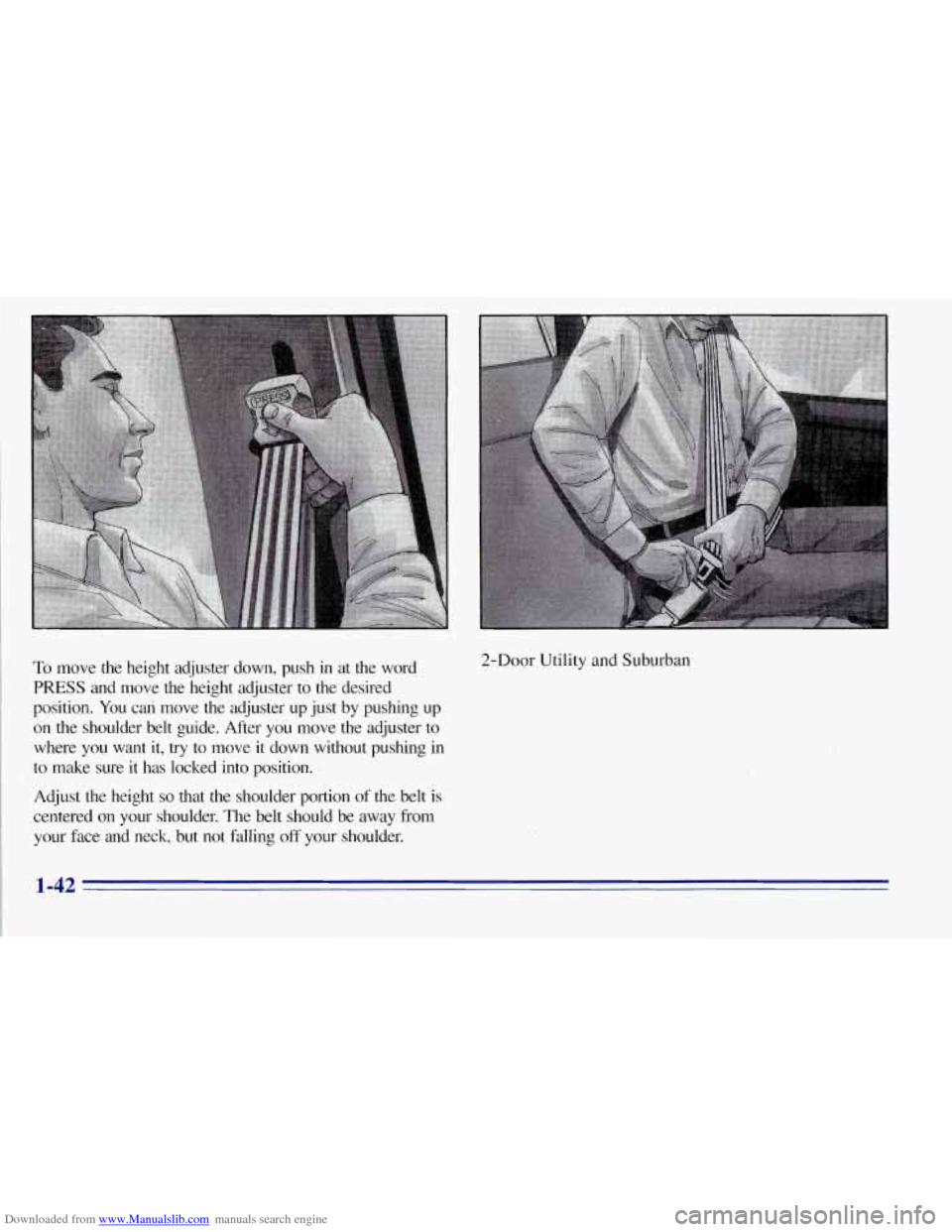
Downloaded from www.Manualslib.com manuals search engine To move the height adjuster down, push in at the word
PRESS and move the height adjuster to the desired
position. You can move the adjuster up just by pushmg up
on the shoulder
belt guide. After you move the adjuster to
where you want it, try to move it down without pushing in
to make sure it has locked into position.
Adjust the height
so that the shoulder portion of the belt is
centered on your shoulder. The belt should be away from
your face and neck, but not falling
off your shoulder. 2-Door Utility and Suburban
1-42
Page 50 of 403
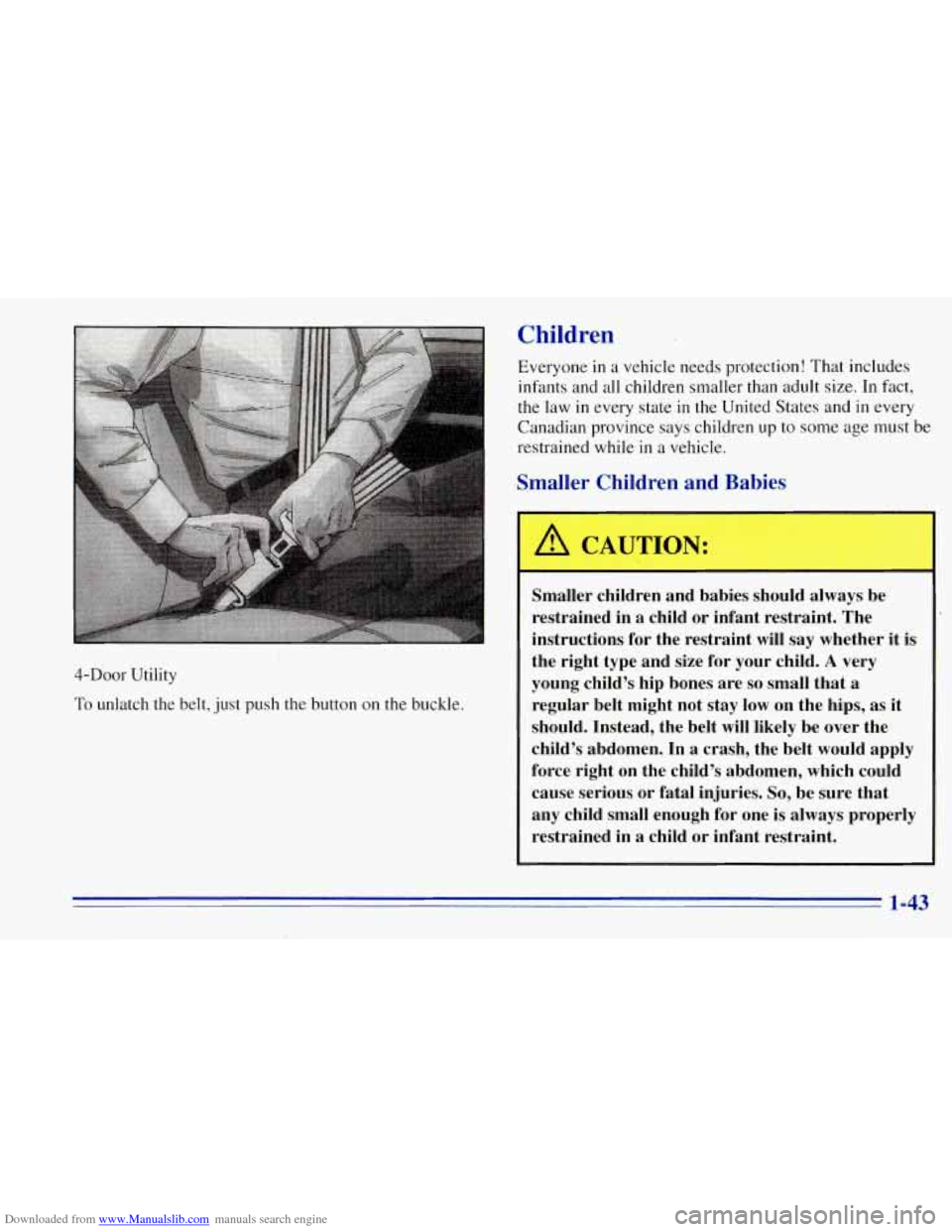
Downloaded from www.Manualslib.com manuals search engine Children
4-DOOr Utility
To unlatch the belt, just push the button on the buckle. Everyone
in a vehicle needs protection!
That includes
infants and all children smaller than adult size. In fact,
the law in every state
in the United States and in every
Canadian province says children up
to some age must be
restrained while in a vehicle.
smaller Children and Babies
A CAUTION:
Smaller children and babies should always be
restrained in a child
or infant restraint. The
instructions for the restraint will
say whether it is
the right type and size for your child.
A very
young child’s hip bones are
so small that a
regular belt might not stay low on the hips, as it
should. Instead, the belt will likely be
over the
child’s abdomen.
In a crash, the belt would apply
force right on the child’s abdomen, which could
cause serious or fatal injuries.
So, be sure that
any child small enough for one is’always properly
restrained in a child or infant restraint.
1-43